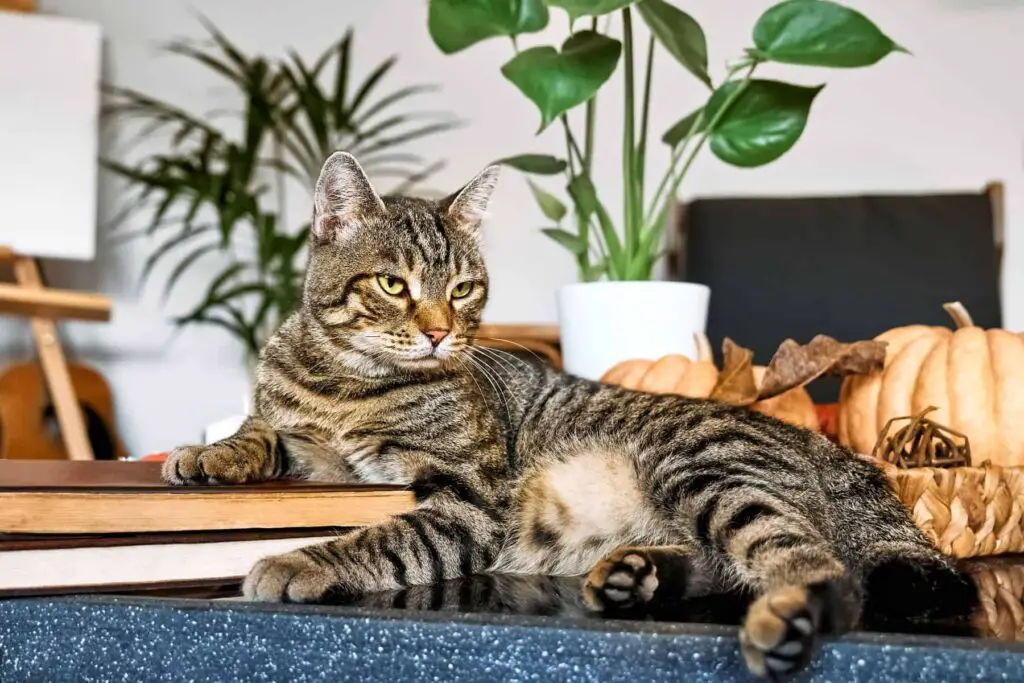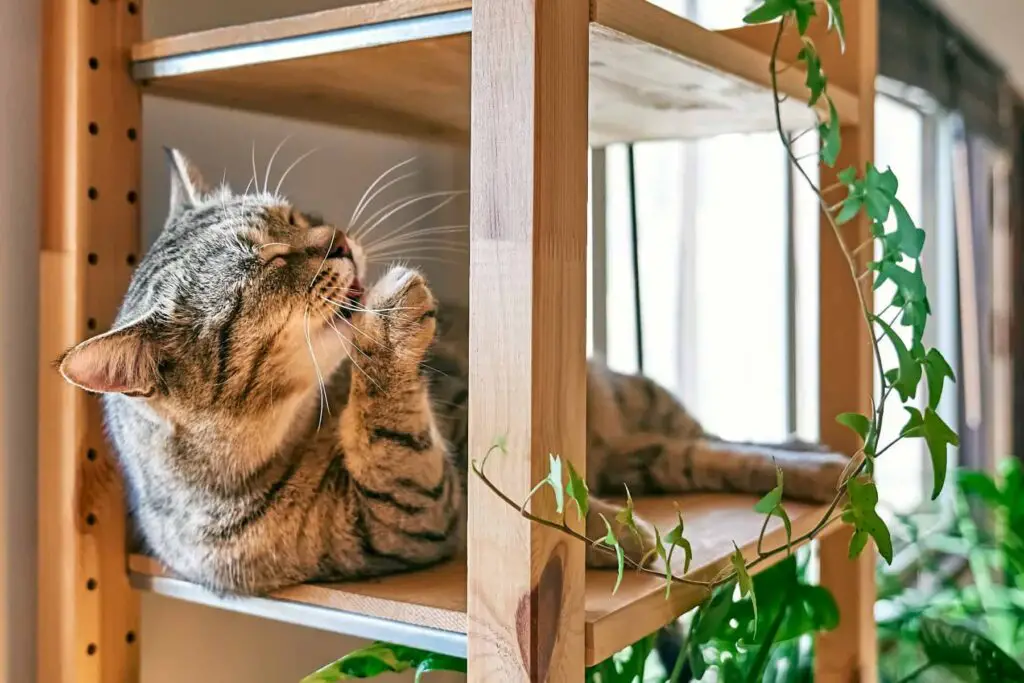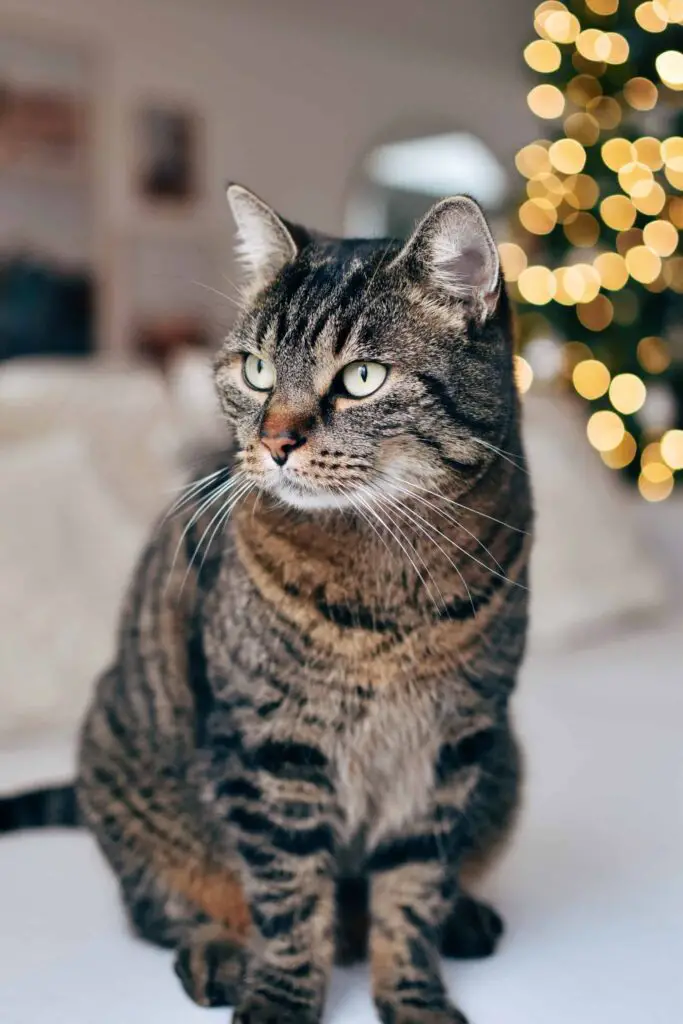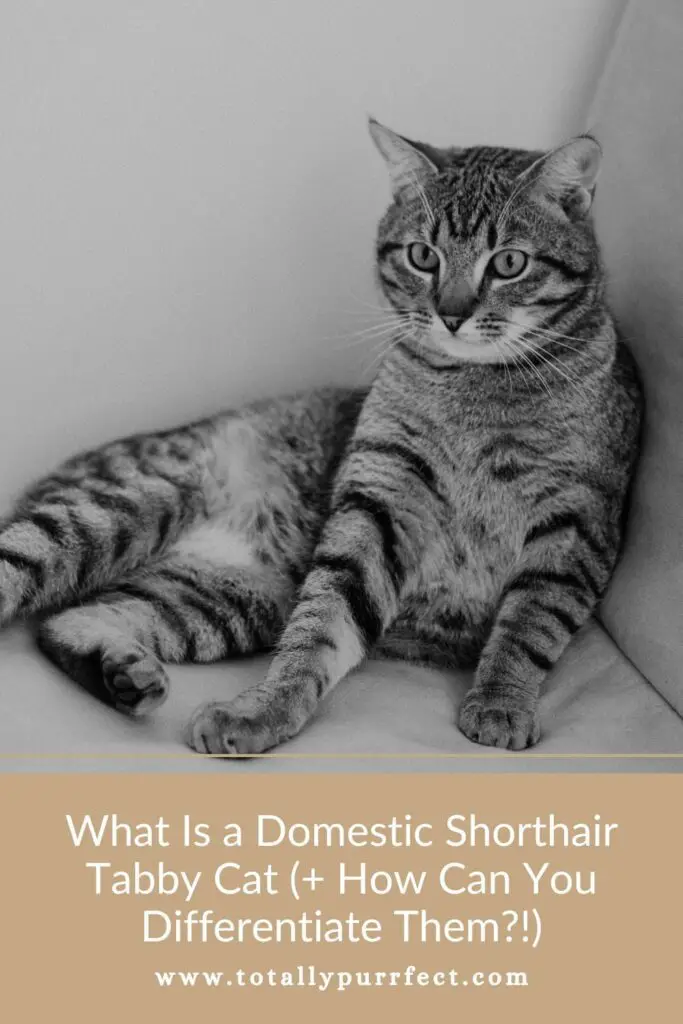Looking to get a domestic shorthair tabby cat? Wondering what exactly they are? What they’re like? And what the difference is between them, and purebred breeds? Then here’s everything you need to know about domestic shorthair tabby cats, in our quick but clear guide. So let’s start from the top, shall we?
What Is a Domestic Shorthair Tabby Cat?
A domestic shorthair tabby cat is a domestic shorthair cat, with a tabby pattern. It’s as simple as that!
But to break this down further, you need to understand what a domestic shorthair cat is. In its simplest form: a ‘domestic shorthair’ encompasses any cat that has been domesticated and has short sleek fur.
A domestic shorthair cat is not actually a breed. Instead, domestic shorthairs are non-pedigree (i.e. they are not of any particular recognised cat breed and they have no breed standard.)
There are actually no clear guidelines for what counts/doesn’t count as a domestic shorthair cat, other than how it looks and where it – seems – to have come from. (And ultimately, they’re pretty wild… And not bred by anyone at all!)
We explore all of this and more in our guide to what a domestic shorthair cat is.
Once you understand this, then it’s all about the “tabby” part. Again, a tabby isn’t a breed either, but instead a coat type seen in almost all genetic lines of domestic cats, regardless of breed. So let’s look at this further…

Types of Domestic Shorthair Tabby Cats (Patterns)
There are five main types of tabby cats that a domestic tabby cat can come in, and therefore be categorised under. (Or, please note – they may be a mix / combination of many.) See, you typically find, there is the…
1) Classic Tabby Cat
The classic tabby has bold, swirling patterns along their sides — much like a marble cake.
2) Mackerel Tabby Cat
A mackerel tabby has narrow stripes that run in parallel down their sides, making them look a bit like a tiger! The body then has narrow stripes running down the sides in a vertical pattern, making them very popular.
3) Spotted Tabby Cat
A spotted tabby has spots all over their sides. These spots can be large or small, and sometimes appear to be broken mackerel stripes. They can be round, oval or rosettes.
4) Ticked Tabby Cat
A ticked tabby cat does not have the traditional stripes or spots on their body, and may not, at first, seem to be a tabby. However, like all tabbies, this coat pattern has tabby markings on the face and agouti hairs on the body.
5) Patched Tabby Cat
This is the term used to describe a tortoiseshell (also called tortie) tabby. In the typical form, there are separate patches of brown tabby and red tabby on the same animal.
A tortie who also carries the tabby gene is often called a torbie. Patched tabbies can show any one of the above four distinct tabby patterns. The markings are usually more apparent on the legs and head.

Types of Domestic Shorthair Tabby Cats (Colour)
So as you can see, there are small differentiations in the patterns on a domestic shorthair tabby cat, which makes them – ever so slightly different – types.
Can you always clearly tell which type they are?
Well not always. Especially as domestic shorthair cats haven’t been bred – they just naturally pick up their tabby markings and so, as mentioned, can sometimes become a combination of the above.
Usually, you’ll simply recognise a domestic shorthair tabby cat by being shorted haired, striped and with that distinctive letter ‘M’ on their forehead.
What is clearer to differentiate however, is the type of domestic shorthair tabby cat you have, based on their colour. So for example, you can have:
- Silver
- Brown
- Blue (Otherwise known as Grey)
- Red (Otherwise known as Ginger!)
Each of these are equally beautiful. In fact, we happen to think – despite not being specifically bred – Domestic Shorthair Tabby Cats can actually be one of the cutest and prettiest, of them all!

What Is The Difference Between a Domestic Shorthair (Tabby) Cat and Other Shorthair (Tabby) Cats?
So, you may have heard of cat breeds like – the American Shorthair cat, British Shorthair cat, Exotic Shorthair cat, or even the Oriental Shorthair cat (because yes, this is indeed, a cat breed!)
American Shorthair cats look the most similar to Domestic Shorthair cats – particularly the American Shorthair Tabby cats. These are commonly mistaken for Domestic Shorthair tabby cats.
In fact, their names can be used interchangeably. And likewise for British Shorthair cats if you’re based in the UK.
But true American / British Shorthairs are purebred (specifically bred by breeders) while Domestic Shorthairs typically have unknown lineage and that is the key difference between them.
They may share similarities in how they look (particularly when it comes to having “short hair” and similar markings), but if a cat has been specifically bred, then that puts them into the category of that specific breed.
Whereas a domestic shorthair tabby cat, is essentially just a short haired tabby, with mixed ancestry.
They’ve not been specifically bred by anyone, they’ve simply descended so are more of a mix, and have more of a “wild” family history. That’s ultimately what it comes down too.
How Common Are Domestic Shorthair Tabby Cats?
The domestic shorthair tabby cat is the most common of all domestic shorthair cats.
Why? Well because, the tabby coat type is seen in almost all genetic lines of domestic cats, regardless of its breed. And so (even without the clear tabby markings), most domestic shorthair cats will have some form of tabby within them.
That’s pretty mind blowing, huh? It means – even a black cat, could actually be a hidden tabby.
(We explored this in our black cat facts… Which really are fascinating!)

How Can You Tell If You Have a Domestic Shorthair Tabby Cat?
So, from what you can gather and from what is clearly identifiable, the easiest way to tell if you have a domestic shorthair tabby cat is to:
1) Look At Their Appearance
Does your cat have the physical appearance of a domestic shorthair? I.E.
- Do they have rounded heads and paws?
- Average sized ears?
- Do they have fairly short, non-fluffy tails?
- Are they a muscular build?
- And medium-sized?
- With a short, sleek coat?
- Then – do they also have signs of a tabby coat?
These are the kind of physical signs you want to be looking out for, so have a look and see how many ring true. (Remember, the “tabby” part, can actually be hidden, so start with all of the other signs first.)
2) Look At Where They Came From
Next – look at where they came from / where you’re getting from. What are their birth mother and father like? Have they been bred at all? What is their history like?
3) Ask Your Vets!
If you’re still feeling unsure – when you take your cat / kitten to the vet after bringing them home and settling them in, ask your vet what they think they are.
The right vets will offer ample advice, insights and support, so you never have to be left feeling unsure.

What Are Domestic Shorthair Tabby Cats Like?
If you do decide to get a domestic shorthair tabby cat (or any domestic shorthair cat for that matter!), I can guarantee you – you’re in for a real treat!
On a personal note, my childhood family cat (before we got our Maine Coon, Cody) was a domestic shorthair tabby and he was the friendliest, funniest, most loving little boy who gave us 18 years, 3 months and 20 days of love and happiness (to be exact!)
When you raise them right and give them everything they need and deserve, they become the “totally purrfect” pet, in so many ways. So, domestic shorthair tabby cats will always have a special place in my heart.
That’s All For This One
So there we have it – our complete guide to understanding what a domestic shorthair cat is, and how you can differentiate them from other similar short haired tabby cat breeds. I hope you’ve found this valuable.
Got any questions? Or any additional thoughts to add? Please don’t hesitate to drop them in the comment box below.
Thank you so much for your time in reading. Be sure to browse our site for more.


Omg thank you for sharing this article. I just realised that my fur baby is in fact, a domestic shorthair cat! This was an interesting read and also very helpful. I’m finally able to tell them apart!